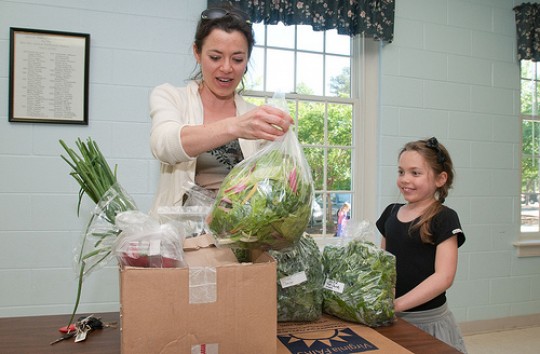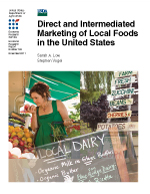New Report: Local Foods are Working for the Nation
New Report: Local Foods are Working for the Nation
The market for local food – food that is produced, processed, distributed and sold within a specific region, say a radius of several hundred miles – is growing. Large, small and midsized farms are all tapping into it. Even better, new data suggest that these producers are employing more workers than they would be if they weren’t selling into local and regional markets.
 Christy (left) and Lilah Talbott of Richmond, VA came to the Fall Line Farms pick-up point at Bon Air United Methodist Church on Thursday, May 5, 2011. USDA Photos by Lance Cheung.
Christy (left) and Lilah Talbott of Richmond, VA came to the Fall Line Farms pick-up point at Bon Air United Methodist Church on Thursday, May 5, 2011. USDA Photos by Lance Cheung.
Those are just a few of the take-home messages from a new report out last week by USDA’s Economic Research Service (ERS). Here’s a quick breakdown of some of the good news I took from this report:
1. Local markets are important for a lot of farmers. ERS finds that a whopping 40 percent of all vegetable, fruit and nut farms in the United States sell their products in local and regional markets. Nearly 110,000 farms across the nation are engaged. Some of these same farms are also selling into national or international markets.
For all of these farms, local markets are key to their bottom line. On average, these farms reported that local food sales accounted for 61 percent of their total sales. Almost two-thirds of the producers, regardless of size, reported that local food sales were at least seventy-five percent of their total sales!
2. The market for local foods goes well beyond direct-to-consumer sales. We already knew that direct sales from farms to consumers was growing – it rose by 215 percent between 1992 and 2007. But for the first time, the new ERS report also looks at what are called “intermediated marketing channels,” or sales from a farmer to a regional distributor, grocer, or restaurant, and then on to a consumer.
Combined, intermediated and direct local food sales totaled nearly $5 billion in 2008. Intermediated sales were three times larger than direct-to-consumer sales – so in other words, farm sales to regional distributors, grocers and restaurants are a big piece of the local food picture.
3. Local doesn’t necessarily mean small. Farms selling locally run the gamut from small to large – those with gross sales under $50,000 to those grossing over $250,000. Large farms are more likely to sell to restaurants, distributors and retailers than are small farms, and direct-to-consumer sales are evenly split between small, midsized and large farms.
4. Local means jobs. One out of every twelve jobs in the U.S. is associated with agriculture, and local food plays a role in that. The ERS report finds that fruit and vegetable farms selling into local and regional markets employ 13 fulltime workers per $1 million in revenue earned, for a total of 61,000 jobs in 2008. In comparison, fruit and vegetable farms not engaged in local food sales employed 3 fulltime workers per $1 million in revenue.
Why is on-farm job creation for producers selling locally so much higher? It will take more analysis to understand these differences, but the take-home message is clear: helping farmers and small businesses develop the infrastructure to produce, store, process, distribute and sell food to consumers in their region is an important component of the work that USDA does to keep and grow jobs in agriculture overall.
###
Direct and Intermediated Marketing of Local Foods in the United States
By Sarah A. Low and Stephen Vogel

Economic Research Report No. (ERR-128) 38 pp, November 2011
This study uses nationally representative data on marketing of local foods to assess the relative scale of local food marketing channels. This research documents that sales through intermediated marketing channels, such as farmers’ sales to local grocers and restaurants, account for a large portion of all local food sales. Small and medium-sized farms dominate local foods sales marketed exclusively through direct-to-consumer channels (foods sold at roadside stands or farmers’ markets, for example) while large farms dominate local food sales marketed exclusively through intermediated channels. Farmers marketing food locally are most prominent in the Northeast and the West Coast regions and areas close to densely populated urban markets. Climate and topography favoring the production of fruits and vegetables, proximity to and neighboring farm participation in farmers’ markets, and good transportation and information access are found to be associated with higher levels of direct-to-consumer sales.
In this report …
Chapters are in Adobe Acrobat PDF format.
- Report summary, 251 kb. | HTML
- Entire report, 3,632 kb.
Charts and graphs (in .png format) from this report are available in the .zip file listed below. The .zip file also contains a document (readme.txt) that lists the name and title of each chart or graph file.
###
About United States Department of Agriculture (USDA)
Mission Statement
The United States Department of Agriculture (USDA) provides leadership on food, agriculture, natural resources, and related issues based on sound public policy, the best available science, and efficient management.
Vision
The USDA want to be recognized as a dynamic organization that is able to efficiently provide the integrated program delivery needed to lead a rapidly evolving food and agriculture system.
Strategic Plan Framework
USDA has created a strategic plan to implement its vision. The framework of this plan depends on these key activities: expanding markets for agricultural products and support international economic development, further developing alternative markets for agricultural products and activities, providing financing needed to help expand job opportunities and improve housing, utilities and infrastructure in rural America, enhancing food safety by taking steps to reduce the prevalence of foodborne hazards from farm to table, improving nutrition and health by providing food assistance and nutrition education and promotion, and managing and protecting America’s public and private lands working cooperatively with other levels of government and the private sector.
USDA Celebrates 150 Years
In 2012, USDA will commemorate and celebrate the 150th anniversary of our founding in 1862, when President Abraham Lincoln signed into law an act of Congress establishing the United States Department of Agriculture.
Two and one-half years later, in what would be his final annual message to the Congress, Lincoln called USDA “The People’s Department.” At that time, about half of all Americans lived on farms, compared with about 2 percent today. But through our work on food, agriculture, economic development, science, natural resource conservation and a host of issues, USDA still fulfills Lincoln’s vision – touching the lives of every American, every day.
“As we commemorate 150 years of accomplishments, USDA is learning from past experiences and looking to the future. In the years to come, we must help address the changing needs of agriculture and rural America. We must continue to help provide a safe, ample food supply for our nation and the world. To meet those goals, we are working to make USDA a more modern and effective service provider and to deliver the best possible results for all of the American people.”
###
* The above story is adapted from materials provided by United States Department of Agriculture (USDA)
![]() ______________________________________________________________________
______________________________________________________________________



















